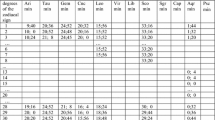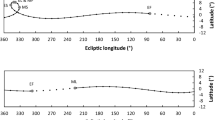Abstract
Models of planetary motion as observed from Earth must account for two principal anomalies: the nonuniform speed of the planet as it circles the zodiac, and the correlation of the planet’s position with the position of the Sun. In the context of the geometrical models used by the Greeks, the practical difficulty is to somehow isolate the motion of the epicycle center on the deferent from the motion of the planet on its epicycle. One way to isolate the motion of the epicycle center is to determine the longitude and time of oppositions of the planet with the mean Sun. A Greek astronomer might have realized that the predictions of mean oppositions by Babylonian models could serve as useful proxies for real empirical observations. It is shown that a Greek astronomer with a reasonable understanding of Babylonian System A models for the outer planets and the Sun–Moon could have used those models to estimate approximate values for the eccentricity e and longitude of apogee A required for geometrical models. The same method would work for the inner planets if conjunctions were observable, but they are not, and the variation of the observable synodic events—first and last morning and evening visibilities—is dominated more by the motion of the planet in latitude than the nonuniform motion of the epicycle center.
Similar content being viewed by others
References
Aaboe A. (1958) On Babylonian planetary theories. Centaurus 5: 209–277
Aaboe A. (1964) On period relations in Babylonian astronomy. Centaurus 10: 213–231
Britton J.P. (2001) Remarks on a System A Scheme for Venus: ACT 1050. Archive for History of Exact Sciences 55: 525–554
Britton J.P., Jones A. (2000) A new Babylonian planetary model in a Greek source. Archive for History of Exact Sciences 54: 349–373
Clarke A.J.M., Steele J.M. (2002) A computer generated Babylonian system A lunar ephemeris. Journal for the History of astronomy 33: 279
Duke D.W. (2005) Ptolemy’s treatment of the outer planets. Archive for History of Exact Sciences 59: 169–187
Duke D.W. (2005) The equant in India: The mathematical basis of Indian planetary models. Archive for History of Exact Sciences 59: 563–576
Duke D.W. (2008) Mean motions and longitudes in Indian astronomy. Archive for History of Exact Sciences 62: 489–509
Duke D.W. (2009) Mean motions in Ptolemy’s planetary hypotheses. Archive for History of Exact Sciences 63: 635–654
Evans J. (1998) The History and Practice of Ancient Astronomy, 362–368. Oxford University Press, New York
Jones A. (1990) Babylonian and Greek astronomy in a papyrus concerning Mars. Centaurus 33: 97–114
Jones A. (1998) Studies in the astronomy of the Roman Period III. Planetary epoch tables. Centaurus 40: 1–41
Jones, A. 1999. Astronomical Papyri from Oxyrhynchus: (P. Oxy. 4133-4300A), 231–232. Philadelphia: Memoirs of the American Philosophical Society.
Jones A. (2006) The Keskintos astronomical inscription: Text and interpretations. SCIAMVS 7: 3–41
Neugebauer O. (1942) On some astronomical Papyri and related problems of ancient geography. Transactions of the American Philosophical Society N.S. 32: 251–263
Neugebauer O. (1956) The transmission of planetary theories in ancient and medieval astronomy. Scripta mathematica 22: 165–192
Neugebauer, O. 1960. A New Greek Astronomical Table (P. Heid. Inv. 4144+ P. Mich. 151). Historisk-filosofiske meddelelser/Det Kongelige Danske Videnskabernes Selskab 39.1.
Pingree, D. 1976. The recovery of early Greek astronomy from India. Journal for the history of astronomy vii:109–123.
Pingree D. (1978) History of Mathematical astronomy in India. Dictionary of Scientific Biography 15: 533–633
Rochberg F. (1998) Babylonian horoscopes, 19–20. American Philosophical Society, Philadelphia
Schmidt O. (1969) A mean value principle in Babylonian planetary theory. Centaurus 14: 253–283
Swerdlow N.M. (1998) The Babylonian Theory of the Planets, 93–94. Princeton University Press, Princeton, NJ
Toomer, G.J., trans. 1984. Ptolemy’s Almagest. London: Princeton University Press.
van der Waerden B. (1957) Babylonische Planetenrechnung. Viertaljahrschrift den Naturforschenden Gesellschaft in Zürich 102: 39–60
van der Waerden B. (1974) Science Awakening II, 250–283. Oxford University Press, New York
Author information
Authors and Affiliations
Corresponding author
Additional information
Communicated by Alexander Jones.
Rights and permissions
About this article
Cite this article
Duke, D. Greek angles from Babylonian numbers. Arch. Hist. Exact Sci. 64, 375–394 (2010). https://doi.org/10.1007/s00407-010-0058-x
Received:
Published:
Issue Date:
DOI: https://doi.org/10.1007/s00407-010-0058-x




